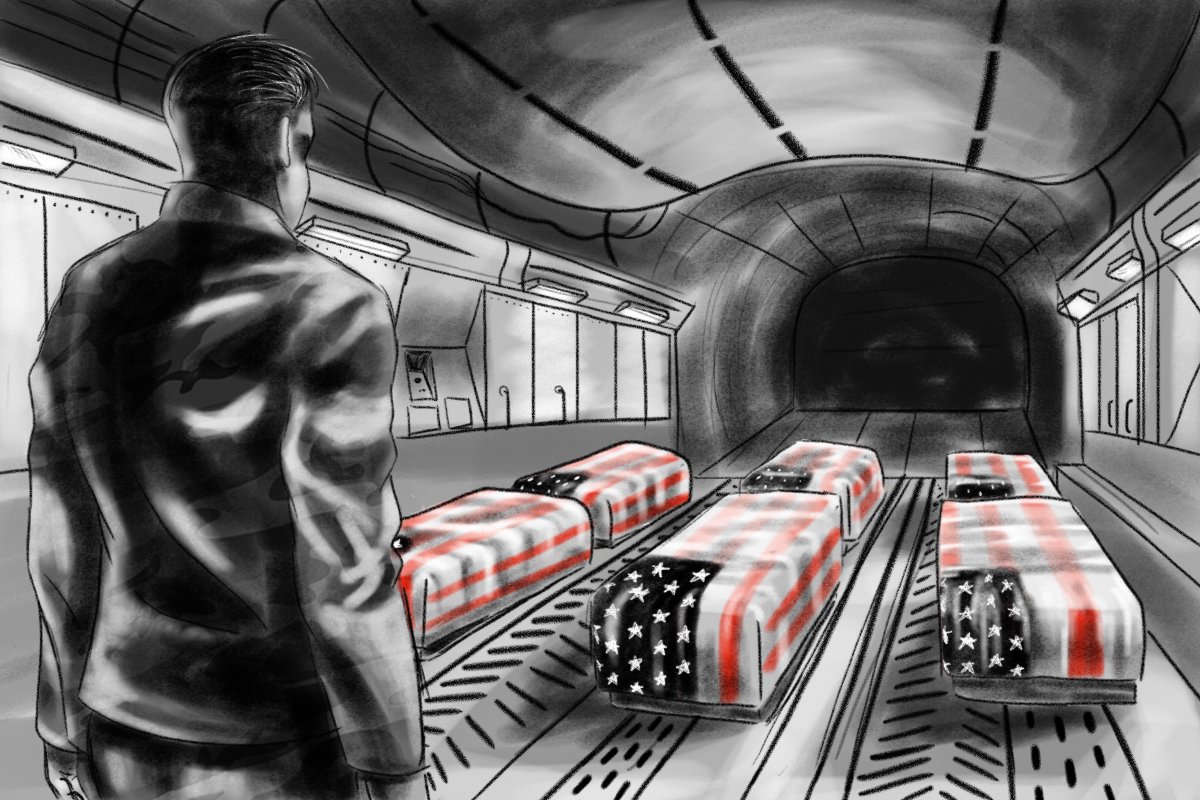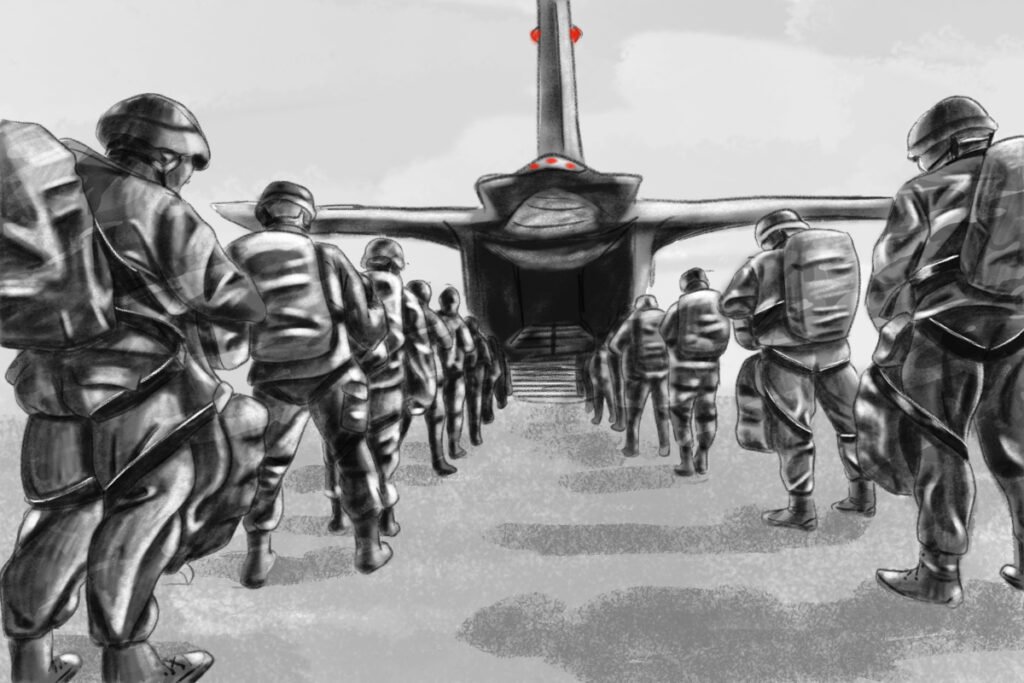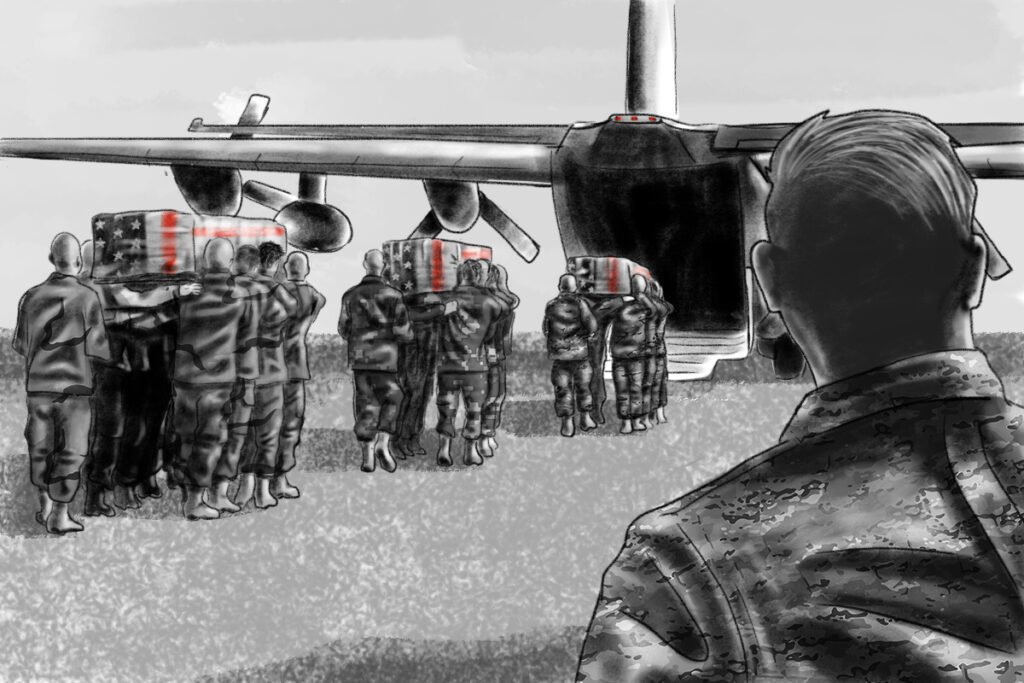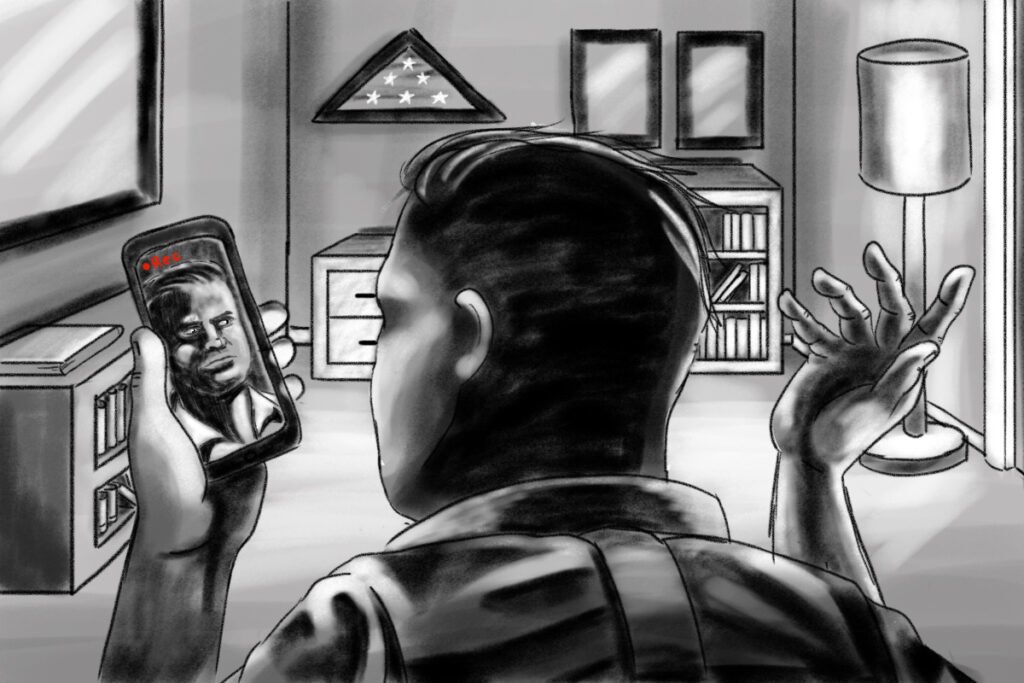
Original art by Lenny Miller/Coffee or Die Magazine.
Keep sending him up,” Viper said. As a child of the ’80s, I tend to use the classics of that period as analogies to help me through life — and “Top Gun” is no exception. These movies have been my unofficial therapists in times before I had one, sometimes to the detriment of my mental health. But sometimes mental health doesn’t matter. Sometimes it’s just business.
As a child, I remember being confused as to why Viper would immediately send Maverick up to fly again after he was cleared of responsibility in the death of his backseater, or why they even investigated him to begin with. I also wondered why Maverick would be conflicted about flying again, even though Goose’s widow implored him to.
I was a staff sergeant — a junior squad leader in the 2nd Ranger Battalion — when I first deployed to combat. I had many peers by my side and served closely with my subordinates. I executed orders, and aside from voicing bitches, gripes, and complaints, I was not yet in a position to implement any changes to standard operating procedure or policy. In retrospect, that phase of my military career seems pretty simple and straightforward. Rangering wasn’t exactly easy, but in those days, it wasn’t complicated either.
The war continued, and I put a few more combat deployments under my belt. But then there was the trip I knew was different than all the rest. I still consider it a defining point in my life, watching too many very competent men killed and wounded during some up-close and nasty fights.
To ease the blow of my seemingly invincible comrades’ deaths, I chalked it up to just being the way combat goes — a law of averages. Of course we had guys killed, I thought. Of course we had guys wounded. We were in combat facing suicidal fanatics every night. I scoffed at the cold-hearted idiocy of “investigations” after people were killed in combat. War is war. People die and it’s no one’s fault but the enemy.
Rangering wasn’t exactly easy, but in those days, it wasn’t complicated either.
When we returned from that deployment, I had a whole new swagger. I had seen the elephant. We constantly evolved to counter the actions of the enemy, but it was never from a place of fear. My frame of reference during those changes was a tactical one, not strategic. But my voice was heard, and I had finally done the things I thought I joined the Army to do.
I was focused when we started training for the next deployment. I was confident and knew without a shadow of a doubt what my men would need to survive the next round.
Training cycles in the 75th Ranger Regiment are predictable, if not mundane when viewed through the lens of someone just returning from combat. Airborne operations were almost always the first up on the training schedule since we almost never conducted them during our deployments. As a jumpmaster, this included going through hours of refreshers, to in turn put novice jumpers through their own refreshers before we started exiting actual aircraft in flight.
As with anything the Regiment does, the T’s were crossed and the I’s were dotted — every aspect of what we did was checked and rechecked. Attention to detail was our hallmark. But that doesn’t mean bad things can’t still happen.
During our first night jump in this block of training, we had a fatality.
Everyone heard the likely scenarios of what caused the death, and everyone agreed: It was no one’s fault, just a dangerous job.
But then the machine went to work. An investigation was put into motion that made me thankful I was not a jumpmaster on the fatality’s aircraft. Our thoughts turned from grieving for the Ranger we’d lost to “whose fault is it?” Simultaneously, our leadership announced that we would be making another, unplanned jump the next day.

Any fear we had of jumping right after a fatality was turned into fiery anger at what we saw as an out-of-touch chain of command who’d have us jump again rather than mourn our fallen. We took our grief and sadness and spun it into laser-focused attention to detail on the tasks at hand.
The next night we conducted the jump, and I would be lying if I said it wasn’t a little bit different. That the stakes weren’t a little bit higher.
My pre-jump routine was flawless, and I inspected every jumper like it was the first and last one I’d ever put out of an aircraft. In doing so, we unknowingly turned that Ranger’s death into something that would be a learning point for every man in that battalion who had to exit an aircraft. It was a lesson we all carried with us for the rest of our careers.
I don’t remember that Ranger’s memorial ceremony, and I didn’t know him that well. But I knew that if I didn’t cut a corner, I wouldn’t have to constantly wonder about it if something catastrophic happened. And I could keep using fate as the excuse. The chain of events portrayed in “Top Gun” made perfect sense: push aside your emotions and make it about business. It’s not healthy, or even right, but it’s sometimes necessary for survival. Especially when you have the lives of others in your hands.
As my deployments stacked up and years passed, I started reading the findings of every after action report. I gained enough experience to read between the lines. I started to notice trends, as did my peers and superiors. These trends shaped the tactics and standard operating procedures that me and many others would carry into every deployment going forward. These changes came to be commonly referred to as “lessons written in blood.”
In the early 2010s, I was on my 14th of what would be 15 deployments. No longer that young squad leader on his first trip, I was the senior enlisted advisor to a regional special operations task force composed of smaller teams dotted across central and eastern Afghanistan. I held this billet during what came to be known as the fighting season, a deployment window every Ranger hopes they get.
And a fighting season we had. This task force was going out nightly on anywhere from one to eight raids during the most kinetic time of the year in arguably the most enemy-populated region of the world at that time.
We fought — a lot.
Besides going out with the platoons I was colocated with and circulating our other outstations to do the same, my responsibilities as the senior enlisted advisor were largely administrative. On numerous occasions I found myself having to be the asshole to guys for doing the same things I did as a junior Ranger.
As the physical challenges of nightly raids in the mountains started taking their toll on my old frame, the mental strain of knowing I had stuck around long enough to become the villain was an equal weight to bear.
This was never more obvious to me than when we had casualties. After the death of a unit member, there are so many administrative requirements put in motion at the leadership level that, if you let it, you stop seeing the deaths as personal and start seeing them as just another part of the job.
On numerous occasions I found myself having to be the asshole to guys for doing the same things I did as a junior Ranger.
In those times, when we took a casualty, my mind immediately went into action on what had to be done right now. I’d seen countless KIAs across the units I belonged to at this point, and someone being killed had shifted from a time to pause, memorialize, and grieve the warriors we’d lost to a time to conduct the unwritten battle drill: react to death.
I focused on the checklist of tasks that ensured the casualty transfer and notification procedures were executed perfectly. It was a no-fail mission, afterall — one we could not fuck up. Many times over I set emotions aside to issue directives down the chain of command in the execution of that mission. This realization, combined with the speed of war, unwittingly put me in Viper’s shoes.
I coldly pushed my men through memorial ceremony rehearsals and grilled leaders for their recently deceased subordinates having not properly filled out their next of kin information. I’m sure those Rangers cursed my actions, and unbeknownst to them, I was cursing myself, too. But there was a mission. I had responsibilities.
I was not armed with the time or the energy to get through those things while also showing empathy to the Rangers that were close with the fallen — or forgive myself for what I was doing. Their deaths became a part of my job, no different than zeroing my weapon or counting a chalk of Rangers onto an aircraft. There were clearly defined steps and clearly defined metrics for success in the eyes of the organization.
My feelings didn’t matter any more than anyone else’s, and certainly they didn’t matter more than the mission. Aside from brief moments of reflection during a memorial ceremony (which also took a backseat to operational requirements), there wasn’t much time or need to fully grieve for and appreciate the immense sacrifice that one of my comrades — or, in a few cases, one of my best friends — had laid down for me.

The best way to put into context all of those deployments, training cycles, and my compounding experiences is to say that I issued myself mental equipment. I put all of my feelings into modular pouches on my emotional plate carrier. Vigilance, fortitude, and aggressiveness were in mag pouches on my non firing side — readily available to close out any and all problems. Presence, self care, and empathy were stuffed into my contingency bag under my bunk, next to those vapor barrier boots and a wool scarf that I also never used.
I transitioned from seeing sacrifices on the battlefield as an unavoidable tragedy to seeing them as problems to solve. What went wrong? What was to blame? Who was to blame? What can we change? What pattern did we fall into that our enemy exploited? What can we do differently from now on? It may seem harsh, but it was necessary to save the lives of others. And, in turn, it was how we truly made the deaths of our comrades mean something, even if we didn’t know it at the time.
Had Maverick been given the all-clear to take a break with no investigation, and had he not been pushed after he went back up, he probably wouldn’t have pulled out of his next flat spin … and we’d all be speaking Russian now.
As leaders, we are told that everything our unit does or fails to do rests on us. This is true. It is always the leader’s fault. But the other golden rule of leadership is to always take care of your people.
With Memorial Day approaching, we will be showered (rightfully so) with the call to arms that we should live amazing lives as a means to celebrate the lost. This is my mantra as well. “Die living” and “live a great story” are the internal pep talks I give myself daily. But how do we take the individual faces we see on every anniversary across the year — and then all of them at once every Memorial Day weekend — and allow ourselves to process and grieve these amazing people? Living life to the fullest is an excellent catch phrase to toss on an Instagram post one day in May. But until we can peel the onion back and take a harsh look at the life we live the other 364 days of the year, are we truly benefiting from the sacrifices we claim to hold so dearly?
We must use the same survival principles that we applied to our formations in the military, but now apply them savagely to ourselves.
Just as we examined deaths in training and combat with a ruthless eye for detail without regard for individual feelings, we must do this to ourselves, too. If we hope to embody the spirit of living our best lives, we need to lose the idea that grief is equal to respect, admit that we want to be happy, and put the deaths of our friends in the same pile of experiences that led us to where we are today.
Until we can peel the onion back and take a harsh look at the life we live the other 364 days of the year, are we truly benefiting from the sacrifices we claim to hold so dearly?
We must apply the rule of “taking care of your people” to ourselves. Just like the unpopular decisions we made as leaders that saved the lives of our subordinates while ensuring mission success, sometimes we have to apply the same harsh, objective analysis to the things we do to survive day to day. Truly examine our lives. Are we living life to the fullest for those whose deaths saved us? Are we celebrating these men and women — or using their sacrifice as an excuse to justify the circumstances of our own habits and decisions?
I struggled for years. Less with the men I knew, loved, and lost, but with my lack of caring. Even as I type this now, I have to remind myself that caring about how it’s all affected me is the true way to honor the fallen. I’ve come to realize that reflection and remembrance is best done while staying in the present. I have come to honor the dead by including them in my present and letting their sacrifice accompany me through all the moments of happiness and triumph I can finally let myself bask in.
This isn’t about me. And it isn’t about you. It’s about the sacrifice of our fallen being something that truly makes the world a better place. We don’t make that happen by posting a picture of a KIA bracelet next to a glass of bourbon and a unit coin twice a year or by wallowing in how empty we think we are without those we lost. We get that by pausing to smile and remember how amazing it is to be alive in the moment we have our breath taken away by a sunset. It takes work and intention to go about your life with a full heart and to love yourself with the same commitment that you loved those men and women you would have given your life for, had things gone a little differently. If they could sacrifice for us, we owe it to them to drop our egos and do the same.

I do this by using my phone to record great parts of my day. I’ll flip on the video camera and talk to one or all of my friends and tell them how amazing I’m feeling. I thank them for the great meal I ate earlier or for the breeze carrying the smell of honeysuckle up my street when I walked my dog that morning. They’re little movies I make for myself to appreciate and remember the moment and to honor the gifts I’ve been given by the men and women of our past. They earned that for us.
Let’s keep the torch of the fallen burning through each of us for as long as we’re blessed to walk this earth. Smile, and speak their names often. Tell their stories, so the dead may never die. This isn’t meant to tell you not to grieve; grief and sadness are as important and powerful as celebration and happiness. But we set aside those feelings for years, and when they come due, that bill will be compounded with interest. You can pay for them, or you can cash them in. No one said it’d be easy — nothing worth having is.
Just ask Maverick.

Jariko Denman is a contributing writer for Coffee or Die. He is a retired US Army Ranger and deployed to combat 15 times in Iraq and Afghanistan from 2002 to 2012, amounting to 54 months of total combat experience as part of a Joint Special Operations Task Force. He now lives in Los Angeles and has advised on several major motion pictures, national ad campaigns, and television series as well as continuing to train and work within government and tactical industries.
BRCC and Bad Moon Print Press team up for an exclusive, limited-edition T-shirt design!
BRCC partners with Team Room Design for an exclusive T-shirt release!
Thirty Seconds Out has partnered with BRCC for an exclusive shirt design invoking the God of Winter.
Lucas O'Hara of Grizzly Forge has teamed up with BRCC for a badass, exclusive Shirt Club T-shirt design featuring his most popular knife and tiomahawk.
Coffee or Die sits down with one of the graphic designers behind Black Rifle Coffee's signature look and vibe.
Biden will award the Medal of Honor to a Vietnam War Army helicopter pilot who risked his life to save a reconnaissance team from almost certain death.
Ever wonder how much Jack Mandaville would f*ck sh*t up if he went back in time? The American Revolution didn't even see him coming.
A nearly 200-year-old West Point time capsule that at first appeared to yield little more than dust contains hidden treasure, the US Military Academy said.












